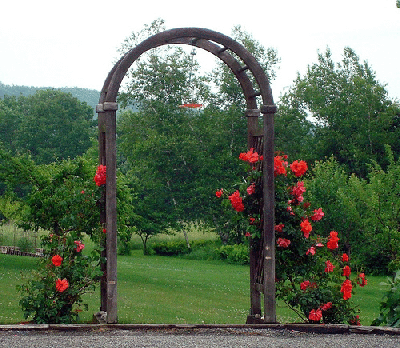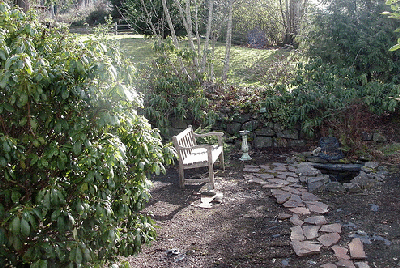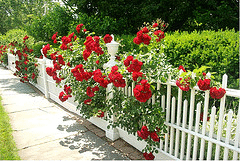Landscape Structure Ideas
Basic design principles can help you incorporate your structure into the landscape
Most landscape structures are used to perform specific functions. Design your structure to specifically meet your personal needs and preference, then design the setting for your structure to be a part of your landscape.
Gazebos are often used to create a cozy secluded quite place. Nestled into a wooded area this gazebo does exactly that. Just a few shrubs left in their natural form unify the gazebo with the setting. A few simple stepping stones leading to the entrance would help join it to the rest of the landscape and invite entrance.
A wide path and entrance opening invite all to enter. This open structure with bench seating all around is ideal for entertaining in a cozy setting. Colorful blooming shrubs encircle the rear, creating a transition between the gazebo and the wooded area, and provide a lively accent that draws attention to the structure.
In rare situations, very little incorporating to the landscape is necessary. This gazebo is constructed from natural materials, the timbers repeating the trees and the floor repeating a rocky base. The gazebo seems to float unanchored, creating a natural and desirable effect of a lookout landing to enjoy a view. When done overlooking water, the floating effect can simulate being on the water. Otherwise, just a few unpruned shrubs on the outer side would transition to the rest of the landscape. A few stepping stones invite entrance from the yard area.
Perched on a hill overlooking a pond, this classic gazebo has a very open structure so as not to restrict the views. Nestled in a wooded spot, cool colored blooming perennials add to the view. The calming cool colors of the blooms contrast the foliage and the water without distracting. What a lovely spot to relax!
This is a classic pergola - support posts with an open structured roof used to lightly shade a pathway. The pathway joins the home with a patio area. Simple greenery anchors the structure to the landscape. Since the function and structure of a pergola is the primary focus, it is not unusual to see them unadorned. Many of us prefer to see climbing vines scampering up the posts.
It has become common to see pergolas attached to the structure of homes, creating filtered shade and visual separation of functional areas. Since they are typically built over concrete patios, it is sometimes more challenging to unify them with the landscape. Here the entire “floor” area is of flagstone and rock, unifying the different functional areas. The same color is repeated in the timbers, stucco, as well as the furniture, making the space seem larger than it is. Accents are quiet and simple. Clipped evergreen globes punctuate the stone wall and spiked blue perennials quietly add color and contrast. Hanging plants are a good way to add vertical accent to attached pergolas, as well as overhead decks.
The use of single post or small scaled pergolas instead of arches has also become quite common. They can offer a little different architecture to your design than the more graceful arches. This pergola over a pathway is anchored with a large pot and bedding plants on one side, and unified with the landscape by shrubs that overlap and border the walkway and pergola.
And why not in an empty dull corner?!? This is a perfect way to enhance a sitting area banished to the corner. The blooming vines are stunning, making you forget about any other elements of the design. But do note the painted fence at left! Great way to disguise a boring fence, balance the heavy blooming over the pergola, and draw the eye to the next element of the landscape, which is a firepit area, out of view here.
A focal point such as this graceful pagoda needs no further adornment. Hanging plants or vines would only detract from the architecture. It is simply grounded to the landscaping with stone block pedestals, which flow right into the pathway border plantings. The curves of the roof structure are repeated in the path and edging of the perimeter planting beds.
A garden arch should always lead somewhere with a path or stepping stones, or open into another area of the property. This arch leads visitors into the interior of the perennial gardens. The arched opening is punctuated with a large pot of bright blooms.
A front entry arch is a perfect accent to the front landscape of a tudor or cottage style home. This arch provides an inviting opening to dense privacy plantings. A path or stepping stones should be added to direct visitors toward the entry sidewalk, which veers off to the drive. Since the door is partially hidden by the tree, trim the lower branch up further and perhaps paint the door an accent color or at least add a pot of bright blooms to draw visitors too the door. (And don’t leave plastic lawn chairs scattered in the front lawn.)
This simple but stunning arch creates a focal point with vivid roses climbing up the sides. The arch beckons visitors to the outer areas of the property, perhaps to stroll or initiate a lawn game. However, the raised timber creates a visual barrier which “stops” traffic. A small flagstone entrance platform or a few stepping stones installed to the level of the timbers would solve the problem.
And of course there is the classic rose arch, engulfed with climbing roses. You need a vigorous variety of rose to accomplish this. The arch opens along a pathway to the garden that is otherwise hidden by the dense growth of shrubbery, which makes visitors anxious to see what lies beyond.
Most landscape structures are used to perform specific functions. Design your structure to specifically meet your personal needs and preference, then design the setting for your structure to be a part of your landscape.
Garden benches are one of the simplest ways to add interest or focal points to your landscape. The bench can be simply decorative such as this one, or provide the function of a sitting space to relax and read, view the landscape, or watch activity. The most important thing to remember is not to just plunk a bench alone in the lawn or it looks temporary rather than interesting or inviting. This one is tucked right into a perennial border along a path, integrating it into the design. The upside down pot along side lime green foliage draws attention to the bench, and the snoozing cat statue invokes a relaxing feeling.
Pavers set into the lawn create a grounded space for a sitting area. The space is easily unified with the landscape by the turf extending between the pavers, allowing this sort of space to be placed easily into any place without introducing unifying plants. Just a couple of small accents will more clearly define the space and soften the edges. Place against a border garden or shrub border gives the area a more relaxing feeling. Placed closer to the home, a more open lively feeling can be created for entertaining.
A sitting area with a bench certainly does not have to be elaborate. This very simple cottage style bench calls attention to dramatic foliage. Sometimes less is more!
This setting is very similar to the one above, but note how the bench here seems a little lost and out of place. The delicate structure does not hold up well to the dense foliage and is completely out of balance. A bench like this would work well in a small patio space accompanied by delicate foliage or blooms. Or perhaps paint it deep red or burgundy-pink to call attention to the red blooms in the background. Now you’ve got a focal point!
Sometimes a bench is nothing more than a supporting part of a larger functional area. The increasingly popular firepit spaces are a perfect example. A flagstone path leads to a firepit “room” in a far corner of the property, extending across the firepit to create a safety zone. There is space to bring chairs for additional guests. The addition of a birdbath pedestal is a small accent that helps create a completely different feeling for the space in daylight, that of a private area to relax quietly.
Garden sheds are such a functional structure they are often forgotten in design. Not so here! The space is highly functional serving several purposes, yet designed and unified as a single space. Absolutely lovely!
But if all you need is a functional shed at the back of the property, this does the trick. And it is every bit as adorable as the one above (as a garden shed should be!) but in a much different way. The rustic style construction works well with the wooded backdrop and woodpile neatly alongside. Shrubby plants flowing up to and around a corner unify the structure easily with the landscape. A path to the door is not necessary to this strictly functional shed, the little step up is enough transition. Love the red wheelbarrow accent!
Most landscape structures are used to perform specific functions. Design your structure to specifically meet your personal needs and preference, then design the setting for your structure to be a part of your landscape.
Even a functional fence should be decorative in some way. The traditional picket fence is versatile enough to use in just about any landscape design. The picket and post style can be the same as or similar to architectural styles of other permanent structures. And it does not have to be a white picket fence! Pickets of natural cedar or painted to match or accent the colors of your home can dramatically change the look and feeling of the fence. Whatever style or color, your fence should be unified with the landscape in some way. Roses, perennials or fine textured shrubs peeking and poking through the fence is an easy way to join a fence to the landscape. Or use planting beds in key spots like corners, gates and openings. Resist the temptation to create a linear perimeter planting, which can further separate the fence from the landscape. A curving perimeter bed that flows out into the lawn is more pleasing and unifying.
A rustic split rail or plank board fence can be more decorative with an interesting design or pattern.
Free standing partial fences are often used as a decorative accent structure in garden beds or island beds in the front landscape. Use three or five (odd numbers) of fence section for the best effect. Posts and caps lend a more formal look. An end post at each side will give the fence piece a more finished look. Decorative partial fences can also be used as a functional screen to hide something unappealing or to create separation of functional areas.
A very basic partial fence can be more decorative painted a lively color. A color already used as an accent to your home will unify the fence to the overall landscape, providing rhythm to attract the eye from a corner planting such as this to other accented elements.
Functional privacy fences are not always attractive. Rather than a large investment in a beautiful fence, why not paint it in some interesting way? This multi-colored pastel fence may not work in many landscape designs, but think of the possibilities. Perhaps three different neutral tones, or a solid color in muted barn red or grayed green that picks up on colors of your home. Ad flowing perimeter shrub borders to screen large portions of the fence as an alternative, or to only allow small portions of a brightly painted fence to peak through.
Don’t let the entry gate of your fence be boring either. An arch or pergola over the entry draws attention and creates an invitation to enter. Slate pieces are added to a gravel path just at the gate entry to further enhance it as a focal point. The lion head knocker is a whimsical touch on the gate. Foliage with interesting texture at either side would complete the design by unifying it with backyard plantings.
This eye catching entry gate leaves no question as to where to enter. Passersby are no doubt drawn to the gate, wondering what other surprises lie beyond. Using the same blue for painted pots or other accents leading through the rear landscape would create a delightful rhythm through the design.
What could be more charming than a potting bench? This one is so elegantly arranged in such a lovely setting, that the unifying elements are one with the bench. Transition to the patio floor is accomplished with tall galvanized French flower buckets on one side and a container of pussywillow on the other. Note how your eye follows a continuous circle from the foreground planting, up the buckets to the wall hung pot, across the top row of pots to the lantern light, down to the pussywillow, and the outward pointing spout of the watering can allows your eye to leave when ready! Situated right under the patio lantern creates a spotlighted focal point at night.
A potting bench is a perfect structure to add whimsical accent to your design. A piece such as this can stand alone as a whimsical statement, or it can be an introduction to whimsical accents used throughout your landscape.
Especially when a potting bench is used at the back of the property, or off in a corner, recycled material is a great way to add a potting bench at very minimal expense. This one was constructed from old barn wood and an old window. The weathered wood becomes a part of the mulch floor and weathering fence. The Red accents are in keeping with the potting bench theme and enhance the red barnwood. Garage sale or flea market sideboards, buffets, computer workstations are also good ideas. A sideboard could be allowed to weather. A computer workstation might need a little paint and disguising.
.





























